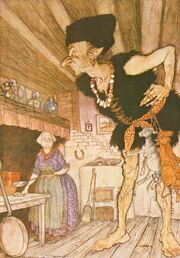
The beanstalk giant and his wife
"Jack and the Beanstalk" is an English fairy tale. It appeared as "The Story of Jack Springis and the Enchanted Bean" in 1734 and as Benjamin Tabart's moralised "The History of Jack and the Bean-Stalk" in 1807. "Felix Summerly" (Henry Cole) popularised the tale in The Home Treasury (1842), and Joseph Jacobs rewrote it in English Fairy Tales (1890). Jacobs' version is most commonly reprinted today and it is believed to be closer to the oral versions than Tabart's because it lacks the moralising.
"Jack and the Beanstalk" is the best known of the "Jack tales", a series of stories featuring the archetypal Cornish and English hero and stock character Jack.
This tale is an Aarne-Thompson tale-type 328, The Treasures of the Giant.
Plot[]
Jack is a young boy living with his widowed mother and a dairy cow as their only source of income. When the cow stops giving milk, Jack's mother tells him to take it to the market to be sold. On the way, Jack meets an old man who offers "magic beans" in exchange for the cow, and Jack makes the trade. When he arrives home without any money, his mother becomes furious, throws the beans on the ground, and sends Jack to bed.
During the night, the magic beans cause a gigantic beanstalk to grow, which Jack climbs to a land high in the sky. When Jack finds an enormous castle, he breaks in. Soon after, the castle's owner, a giant, returns home. He senses that Jack is nearby, and speaks a rhyme: Fee-fi-fo-fum! I smell the blood of an Englishman,Be he alive, or be he dead,I'll grind his bones to make my bread.When the giant falls asleep Jack steals a bag of gold coins and makes his escape down the beanstalk.
Jack climbs the beanstalk twice more. He learns of other treasures and steals them when the giant sleeps: first a goose that lays golden eggs (the most common variant is a hen; compare the idiom "to kill the goose that laid the golden eggs."), then a harp that plays by itself. The giant wakes when Jack leaves the house with the harp and chases Jack down the beanstalk. Jack calls to his mother for an axe and before the giant reaches the ground, cuts down the beanstalk, causing the giant to fall to his death. Jack and his mother live happily ever after with the riches that Jack stole.
Origins[]
"The Story of Jack Spriggins and the Enchanted Bean" was published in the 1734 second edition of Round About Our Coal-Fire. In 1807, Benjamin Tabart published The History of Jack and the Bean Stalk, but the story is certainly older than these accounts. According to researchers at Durham University and the Universidade Nova de Lisboa, the story originated more than 5,000 years ago.
In some versions of the tale, the giant is unnamed, but many plays based on it name him Blunderbore. (One giant of that name appears in the 18th-century "Jack the Giant Killer".) In "The Story of Jack Spriggins" the giant is named Gogmagog.
The giant's cry "Fee! Fie! Foe! Fum! I smell the blood of an Englishman" appears in William Shakespeare's early-17th-century King Lear in the form "Fie, foh, and fum, I smell the blood of a British man." (Act 3, Scene 4), and something similar also appears in "Jack the Giant Killer".
Analogies[]
The Brothers Grimm drew an analogy between this tale and a German fairy tale, "The Devil With the Three Golden Hairs". The devil's mother or grandmother acts much like the giant's wife, a female figure protecting the child from the evil male figure.
"Jack and the Beanstalk" is unusual in that the hero, although grown, does not marry at the end but in some versions, returns to his mother. In other versions he is said to have married a princess. This is found in few other tales, such as some variants of "Vasilisa the Beautiful".
The beanstalk is reminiscent of the ancient Northern European belief in a world tree connecting Earth to Heaven.
Controversy[]
The original story portrays a "hero" gaining the sympathy of a man's wife, hiding in his house, robbing, and finally killing him. In Tabart's moralised version, a fairy woman explains to Jack that the giant had robbed and killed his father justifying Jack's actions as retribution. (Andrew Lang follows this version in the Red Fairy Book of 1890.)
Jacobs gave no justification because there was none in the version he had heard as a child and maintained that children know that robbery and murder are wrong without being told in a fairy tale.